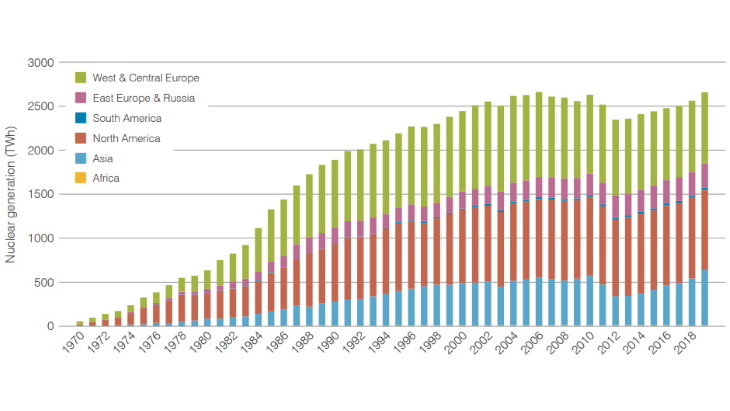Nuclear reactors generated a total 2657 TWh of electricity in 2019, up from 2563 TWh in 2018, and second only to the 2661 TWh generated in 2006, according to a new World Nuclear Association report. This is the seventh successive year that nuclear generation has risen, it noted.

In the World Nuclear Performance Report 2020, the Association details power generation and construction achievements for the previous year. In addition, the report features five case studies covering topics including reactors in France being operated in load-following mode, the operation of reactors during the COVID-19 pandemic,commissioning of the Sanmen 1 AP1000 and the start up of the UAE's first reactor.
At the end of 2019, the global capacity of the 442 operable reactors stood at 392 GWe, down 5 GWe compared with the end of 2018. Six new reactors were connected to the grid, with a combined capacity of 5.2 GWe. Five reactors with a combined capacity of 5.8 GWe started construction in 2019, two in China and one each in Iran, Russia and the UK. The total number of reactors under construction fell by one to 55 over the course of 2019. Thirteen reactors - including four in Japan that had not generated electricity since 2011 - were shut down, with a combined capacity of 10.2 GWe.
The median construction time for reactors starting up in 2019 was 117 months. This is above the average achieved since 2001 and is in part due to the majority of reactors entering service last year being first-of-a-kind (FOAK), or reactors that started construction soon after the initial FOAK reactor.
The capacity factor for the global fleet stood at 82.5% in 2019, up from 79.8% in 2018. "In general, a high capacity factor is a good indication of excellent operational performance," the Association said. "However, there is an increasing trend in some countries for nuclear reactors to operate in a load-following mode, which will reduce the overall capacity factor."
Five reactors reached 50 years of operation in 2019. The Association noted there is no age-related decline in capacity factor seen in nuclear reactor performance, with average capacity factors increasing with age for reactors between 40 and 50 years old.
"In 2019, nuclear electricity generation rose for the seventh year running, demonstrating excellent performance," said Agneta Rising, director general of World Nuclear Association. "In 2020 the world's nuclear reactors have shown resilience and flexibility, adapting to changes in demand while ensuring stable and reliable electricity supplies."
World Nuclear Association said action is needed now to kick-start more than 100 new reactor construction projects that would generate jobs, boost economies and make a major contribution to a clean energy future.